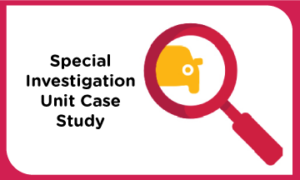Insurance Fraud can be classified into two categories: hard fraud and soft fraud. Hard fraud is the deliberate falsification of a claim. Soft fraud is viewed as a crime of opportunity, such as padding a legitimate claim to gain additional money from the insurance carrier. According to the National Insurance Crime Bureau (NICB), “10% or more of property-casualty insurance claims may be fraudulent.” The NICB also states that all consumers are victims of insurance fraud. “Not only does fraud cause higher insurance premiums for all of us, it also raises our taxes and inflates prices for consumer goods,” the NICB says.
Maryland Auto takes the prevention of insurance fraud seriously by implementing measures to flag suspicious claims through technology, and through ongoing training of all claims professionals to identify the signs of fraud. If a claim presents fraud indicators, it is sent to our Special Investigations Unit (SIU) for further investigation.
A recent case began with the report of a hit-and-run collision between our policyholder’s parked car and a “phantom” vehicle. A “phantom” vehicle is an unidentified vehicle that flees the scene of an accident.
The adjuster immediately identified some suspicious indicators in this case. Although the policy had only been in force for a short period of time, the policyholder had already reported three claims, or “losses,” on the policy.
As the investigation proceeded, additional fraud indicators were noted. There were inconsistencies regarding the number of people in the insured vehicle at the time of the incident, and the alleged occupants provided varying accounts of the facts of the accident. In addition, they claimed to have been injured in the collision, even though no one requested medical assistance at the scene.
Concerned that this may be a “staged” accident – meaning that the accident was planned and that the occupants’ injuries may have been fabricated, the claims representative referred the case to the SIU.
Upon reviewing the body-worn camera footage obtained from the Baltimore City Police, the SIU discovered that only three individuals were present near the insured vehicle when the police arrived at the scene. Additionally, a second vehicle that was not involved in the alleged accident, was double-parked at the scene of the incident, which could indicate that additional “occupants” arrived at the scene after the supposed crash. The camera footage also confirmed that there was no debris on the street resulting from the collision. No other witnesses were identified at the scene and the police did not write a report.
The SIU conducted a license plate reader search on the insured vehicle. License plate readers are located around roadways, which include poles, streetlights, highway overpasses, and even on police cars, and capture license plates and photos of vehicles passing these computer-controlled cameras. In this case, the search revealed a photo of the insured vehicle showing similar damages to what the insured had described from the hit-and-run, and the photo was taken the day prior to the crash.
Maryland Auto received a notification from another insurer’s SIU department informing us that they had also encountered questionable claims involving our policyholder. Checking the Insurance Services Office (ISO) ClaimSearch and NICB databases, the investigator verified that there were indeed questionable prior auto injury claims.
Due to the concerns associated with the claim, SIU requested an Examination Under Oath (EUO) of all five reported occupants, even though the camera footage from the body-worn camera showed only three at the scene of the crash. Only four of the five occupants appeared with their attorney to provide testimony. The four combined EUOs did not resolve the SIU’s concerns, since their testimonies contradicted each other.
After careful review, the claim was denied for questionable facts and material misrepresentation. The case was then referred to the Insurance Fraud Division of the Maryland Insurance Administration as required by Maryland law.
Following the denial, the five alleged occupants filed suit against Maryland Auto, in which our SIU and Claims teams testified on behalf of Maryland Auto. The medical bills for these plaintiffs totaled over $25,000. One occupant failed to appear, and two were late and did not testify. The two occupants who did testify offered conflicting statements, and neither could describe the phantom vehicle that hit the one they were occupying.
In the end, the judge dismissed three of the cases – one for failing to appear in court, another for failing to submit to an EUO, and the third for not testifying on liability. Despite hearing testimony from the other two individuals, the judge found it to be lacking in detail and did not believe that the accident occurred in the way it was described. Additionally, damage photos submitted at trial did not match either account. The judge ruled in favor of Maryland Auto and dismissed all five cases.
This claim highlights the great work of Maryland Auto adjusters in identifying suspicious claims and referring them to the SIU, which was able to fully investigate and prevent payment on a case of fraud.




